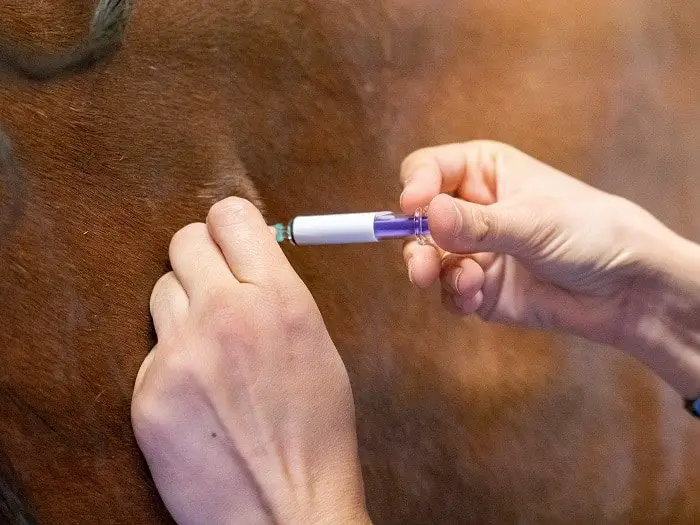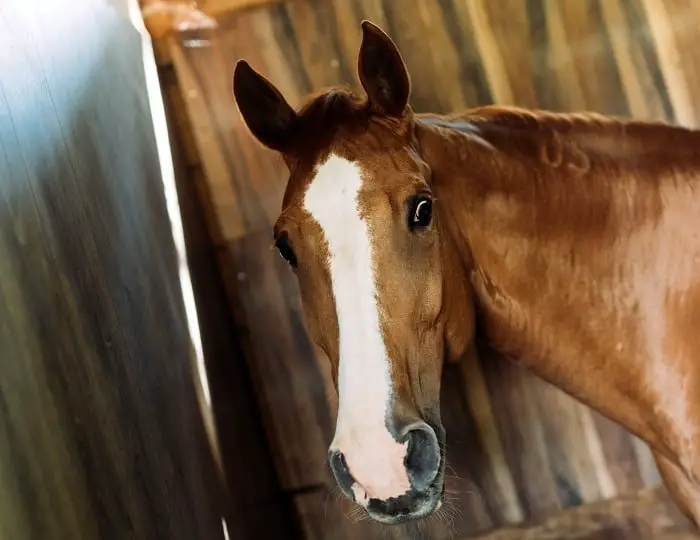Last Updated on April 11, 2020
The word “rabies” brings up images of rabid animals, foaming at the mouth, and movies where such animals had to be shot or put out of their misery. It’s a term dreaded by all, especially by animal owners. What about rabies in horses?
While it’s a hard topic to think about, it’s an important topic to discuss. Rabies can affect all species of animals, and it can affect people.
In this article, I’ll be discussing rabies as it pertains to horses; whether or not horses can get rabies, how they get it, and what to do if they have it. As with all other medically related questions, please consult your vet before making any important decisions.
Rabies in Horses: Is it Possible?
The simple answer to this question is, yes, horses can get rabies. Horses run the same risk of getting rabies as any other animal that spends time outside. Horses, cats, dogs, and any other domestic animal that spends time outside runs the risk of getting rabies.
How Do Horses Get Rabies?
This has to do with how rabies is transmitted. An animal is infected with rabies when their bloodstream comes into contact with the saliva of an animal already affected with rabies. If this contact does not occur, the animal will not get rabies; there is no other way for the disease to be contracted.
Take, for example, the following: horses are turned out at night. An opossum with rabies enters the pasture and attacks a horse laying down. The opossum would have to bite the horse, and its saliva would have to penetrate through the horse’s skin, through the bite punctures, in order for the horse to contract rabies.
Possibly due to the fact that horses have extremely thick skin, possibly due to the fact that horses are huge and fast creatures of flight, there aren’t many cases of equine rabies. There are many more cases of rabies in other domesticated animals, such as cats and dogs.
The Center for Disease Control and Prevention estimates that the average number of equine rabies cases annually in the USA ranges from 42-82. This means that less than two rabies cases occur per state, per year.
Rabies in Horses: Prevention
There’s good news and bad news when it comes to equine rabies. The good news is that it is nearly 100% preventable. The equine rabies vaccine has a near-perfect success rate, and it is regularly administered by equine vets.
If you’re purchasing a new horse, make sure you have a copy of their most recent vaccine record. If they haven’t had a rabies vaccine in the last year, that should be on the top of your priority list.
If you’re maintaining a horse you’ve owned for a while, simply make sure that he stays on a regular vaccine cycle, and he’ll be protected from this horrible disease.
Rabies in Horses: Steps to Take
The bad news about equine rabies is that it does not have a cure. Once a horse contracts rabies, it will be killed by the disease within a few weeks.
The hardest part about this is that there is no test that can be done on a living horse which will determine if the horse has rabies or not. There is no way to know for sure if that is the cause of the horse’s distress and pain until after the horse’s death.
This fact makes what is to come next even more important; you (and your vet) must know what to look for if you suspect that your horse has rabies. It is important to know the symptoms very well.
It is also important to know how to handle an infected horse, so that other horses, animals, and people do not risk infection.
Symptoms
Vets say that rabies looks different in every horse. Horses can become lethargic, aggressive, irritable, mean, sad, and more. Sometimes there will be excessive sweating or drooling.
Because these symptoms can also be symptoms of other, less severe illnesses, always consult your vet before assuming your horse has rabies.
There will also need to be a definite bite mark or skin puncture, where the horse would have been exposed to rabies. Often, horses fixate on this area, because it causes pain. They will often rub the skin raw, bite at it, try to stomp at it or scratch it– anything to stop the pain or itching.
If there is no puncture in your horse’s skin, the horse cannot have rabies. Again, always consult your vet before assuming the worst, especially if your horse has been vaccinated against rabies. There are many other sicknesses that have similar outward symptoms as rabies.
Steps
If you and your vet together conclude that your horse, unfortunately, does have rabies, there are many important steps that must be taken to ensure the safety of everyone around.
Your horse can transfer rabies the same way he got it; by your internal exposure to his saliva. If he bites you and punctures your skin, you will also contract the disease. Rabies isn’t curable in humans either.
Your horse will need to be separated from all other horses and animals. From there, the infected horse must be treated with extreme caution. Depending on the horse’s symptoms, it may be smart to only interact with the horse when it is sedated.
It may also be in your best interest to wear arm-length leather gloves when handling the horse. Again, this conduct will depend on the horse’s symptoms and behavior. But, when it comes to a disease like rabies, it’s better to be safe than sorry.
Conclusion
Rabies can be a tough topic to think about but it is important to understand and discuss it, in order to best protect your horse’s wellbeing, your wellbeing, and the wellbeing of other horses and animals.
The good news is that rabies is 100% preventable; simply make sure that your horse is up to date on its vaccines, and infection shouldn’t be an issue.
I hope this article helped inform you about rabies in horses! If so, please share this article, and share with us your experiences dealing with rabies in horses and other animals!
Michael Dehaan is a passionate horse owner, horse rider, and lover of all things equine. He has been around horses since he was a child, and has grown to become an expert in the field. He has owned and ridden a variety of horses of different breeds, and has trained many to compete in shows and competitions. He is an experienced horseman, having worked with and competed many horses, including his own. He is an active member of the equestrian community, participating in events and teaching riding lessons.


